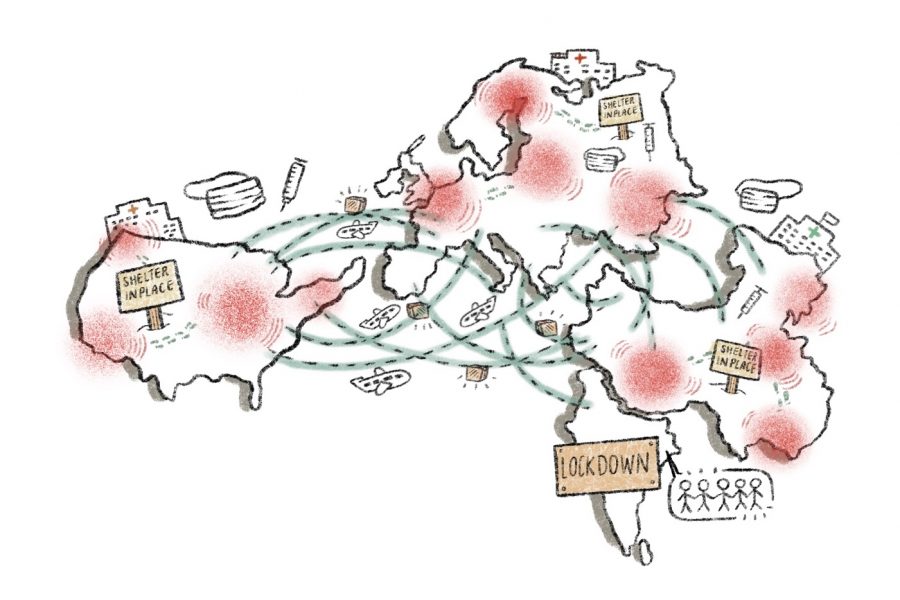Developing countries act more decisively against COVID-19
Across the globe, developing countries are taking more drastic actions to reduce the spread of COVID-19, compared to their first-world counterparts.
May 3, 2020
The current COVID-19 outbreak has devastated the world, but based on its pattern of destruction, the virus appears to be affecting first-world, economically essential countries disproportionately, and it will likely continue its rampage in the same manner.
According to the Johns Hopkins University CSSE, as of 10:32:29 a.m. today, the U.S. alone has confirmed 1,138,690 cases and 66,570 deaths. Norway, ranked No. 1 by the Human Development Index, has 7,809 cases out of a mere population of about 5.42 million. Europe overall, where most developed countries are found, has 3,388,665 confirmed cases, with 243,312 of them resulting in fatalities.
These numbers are shockingly high, and there’s a very tangible reason for why the number of coronavirus cases is concentrated in a few select locations. These developed nations tend to have more domestic and international travel, including to China, the origin of the virus, increasing the opportunity to both get and spread COVID-19. Additionally, these nations outsource many of their products, increasing the number of people coming into contact with items from all over the world.
Comparatively, the number of cases in third-world countries is very low. India, a nation with a population of 1.39 billion, has just 40,263 confirmed cases as of 10:32:29 a.m. today (Johns Hopkins University CSSE). All of Latin America has less cases than the U.S. combined. Most African countries, with the exception of South Africa and those bordering Europe, have 1,000 or less cases.
These statistics raise many suspicions: how is it that developed countries have a harder time containing this virus than developing countries with fewer resources? Perhaps the seasons theory is true — most developing nations are in the southern hemisphere, where the weather is different, so when the seasons shift, the amount of cases will also flip. There’s the fact that developing nations have fewer tests available, and therefore, fewer cases are reported.
However, according to National Geographic, seasonality in other major coronaviruses, SARS and MERS, isn’t visible. SARS seemed to barely show a pattern of seasonality, but scientists don’t know if that was due to temperatures and humidity or containment, while MERS doesn’t show any signs of seasonality. This reduces the chance that COVID-19 will change with temperature.
Additionally, even with fewer reported cases, developing countries are pushing stricter restrictions on their populations compared to countries with a high number of cases.
Developing nations know that their lack of resources will prevent them from recovering if they get hard hit. Unlike developed countries, these nations are focusing on being preventative rather than remediative. They are stopping the virus from exploding in cases rather than trying to heal a country stricken with infection.
First-world countries are taking action: communities have come together to sew masks for hospital workers and many counties have decided to shut down schools and large public spaces. Public transportation and essential services remain open, however, and some U.S. states have begun opening shelter-in-places. Although the American government has left individual states to decide their own quarantine measures, many governors have taken serious action.
Nevertheless, relative to these nations, third-world countries have imposed considerably stricter regulations. India, for example, has shut down all public transportation, stores and schools, resulting in a nationwide lockdown, rather than instituting state-by-state shelter-in-places. On top of the federal regulations, social actions are being taken, like shopkeepers creating six feet distance gaps between customers.
The biggest asset developing countries have, however, is their sense of unity. Developed countries have community events being planned by small, individual groups, providing comfort to them but unable to unite the whole nation. Developing countries have nationwide events; the Prime Minister of India regularly holds moments of recognition for healthcare workers, from lighting candle vigils to having the whole nation applaud them together.
These actions motivate people to stay inside and keep the nation safe, providing an incentive that first-world countries desperately lack.
As of yet, developing nations don’t seem to be at the biggest risk for economic and social distress compared to large, economically essential first-world countries. If a third-world country gets hit, it will be disastrous for a variety of reasons, from lack of resources to weaker political infrastructures. However, knowing and recognizing these risks will ensure that third-world countries take excess precautions to keep their populations safe.



